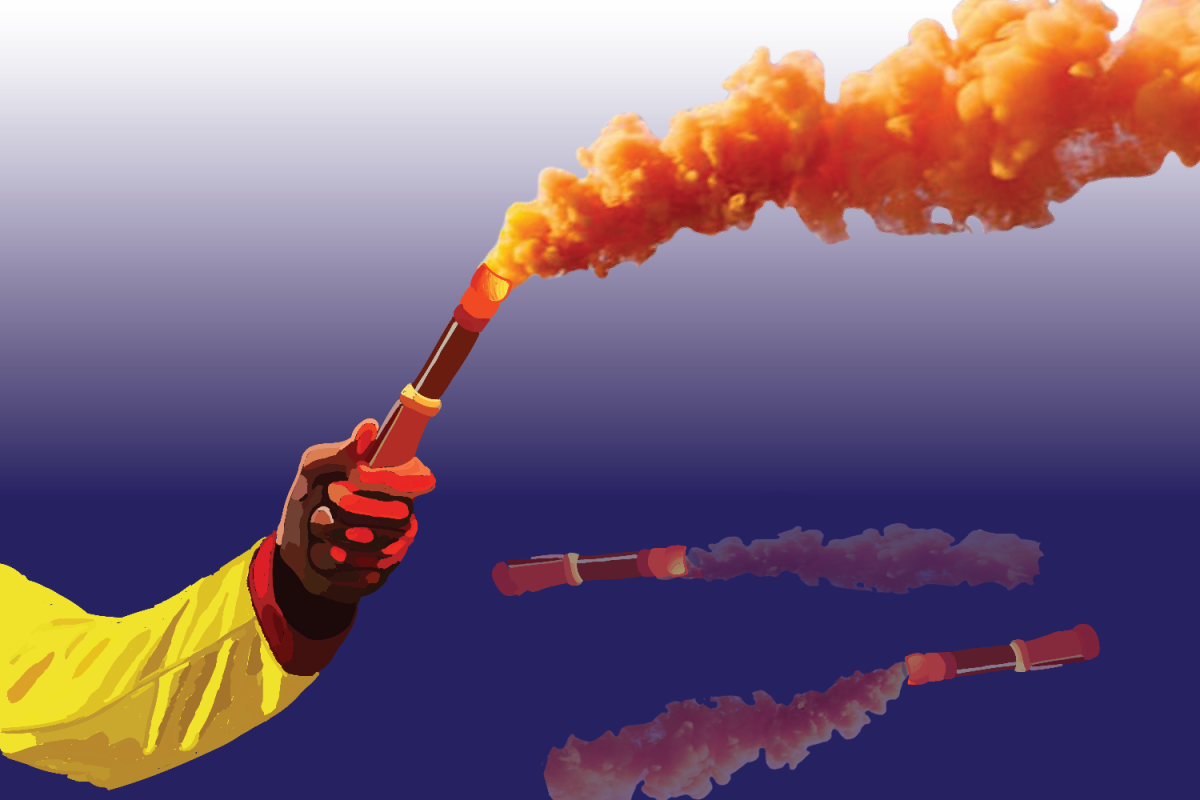In the world of boating, pyrotechnic marine flares are a common sight. Many boaters, however, are unaware of the dangers that they can pose to both human health and the environment.
These devices are designed to emit a bright light or colorful smoke, serving as a signal to attract attention and pinpoint a boater’s precise location during emergencies.
The U.S. Coast Guard (USCG) requires nearly all vessels over 16 feet long operating on coastal waters, the Great Lakes, territorial seas, and waters directly connected to them to carry approved visual distress signals. By law, boats must carry three accessible, approved visual distress signals at all times for both day and night use.
While their main purpose is to ensure boating safety, after expiring, pyrotechnic marine flares become explosive, hazardous waste that requires special, costly handling and disposal.
“The flares use many toxic chemicals designed to remain flammable and burn in wet marine environments, including perchlorate and metals, which can leach into the drinking water supply and damage the environment when they’re improperly disposed of,” said Vivian Matuk, the Environmental Boating Program Manager of the Division of Boating and Waterways at California State Parks.
As pyrotechnic marine flares expire, their chemical properties become increasingly hazardous.
Materials like strontium nitrate, strontium peroxide, potassium nitrate, and potassium perchlorate, some of which are toxic and regulated by the U.S. Environmental Protection Agency (EPA), pose a contamination risk to land, air, and waterways.
Even when they’re not expired, they present a serious fire risk, especially when misfired or improperly used for celebratory occasions. In fact, they share many similarities with fireworks in terms of their chemical compositions and potential for environmental harm, contributing to air and water pollution, soil contamination, and potentially harming aquatic and terrestrial ecosystems.
Simply throwing expired flares in the trash may cause the highly toxic chemicals in these flares to be exposed to other chemicals found in household items, making them greater threats to the environment and human health.
However, there is no single agency or organization in the U.S. that handles the disposal of expired flares and there are no permanent safe disposal options in many California counties.
Transporting expired flares necessitates obtaining State and Federal permits from agencies like the California Department of Toxic Substance Control (DTSC), the U.S. Department of Transportation, and the EPA. Strict regulations dictate their storage, transportation, and disposal to ensure safety and compliance.
The flares expire after just 36 to 42 months, presenting many additional problems.
“This means that every year or two, boaters are constantly buying these single-use pyrotechnic marine flares when there’s actually no good way to get rid of them,” said Liliana Mejia, environmental health program supervisor at San Mateo County Health.
Not to mention that it costs anywhere from $7 to $50 for a single flare to be properly disposed of at a permitted facility, according to the California State Parks’ Division of Boating and Waterways.
This money goes into the packaging, disposal, and transportation costs involved with safe disposal, which is a huge cost burden for public and governmental agencies.
“Many boaters end up piling them in their garages or on their boats. I’ve also heard of some boaters who just throw them into the water, which causes severe contamination issues. Once the perchlorate is in the water, there’s basically no way to get it out. All of our waters are connected. Once you put it in one area, it becomes a problem for everyone,” said Yalin Li, Senior Associate at the California Product Stewardship Council (CPSC).
Research has linked perchlorates to thyroid dysfunction in humans and potential carcinogenicity. A Rhode Island Department of Health study found that just one improperly disposed marine flare can contaminate up to 240,000 gallons of groundwater.
Consumer concerns and the advocacy of environmental and safety organizations, both local and national, have prompted government agencies like the USCG to explore alternatives to pyrotechnic flares for boaters.
Once the perchlorate is in the water, there’s basically no way to get it out. Once you put it in one area, it becomes a problem for everyone.” — Yalin Li
Non-pyrotechnic electronic devices, also known as electronic distress signal devices (eVDSDs), never expire and can last the lifetime of a boat.
Although many agencies and organizations hold community events for boaters to drop off expired flares and encourage them to consider switching to reusable eVDSDs, the adoption of this environmentally friendly alternative remains a gradual process.
“Pyrotechnics are still going to be around for quite a while, and we’re unlikely to unseat them soon. Realistically, a lot of people don’t like change, but we’re kind of seeing a slow transition of people going towards the LEDs, but it’s a slow process because we have to accompany it with education,” Li said.
What’s more, according to Li, is that costs may deter boaters from making the switch from pyrotechnic flares.
“LEDs are just really expensive. Right now, the average is around $100 to $300 per device, and although you have it for a lifetime, the upfront costs can be a barrier to certain people,” Li said. “A lot of fishermen don’t make a ton of money, so they might not be able to immediately spend $300 on a flare when a single-use one only costs about $12.”
These components all play a role in the continued prevalence of pyrotechnics flares among the boating community.
“Until there are more competitive alternatives to pyrotechnic marine flares, manufacturers need to offer a disposal method that is as easy as purchasing them. Ideally, this could look like a State Extended Producer Responsibility (EPR) program where consumers can return the expired flares to the producers, generally via the retailer that sells them,” Mejia said.
An estimated 174,000 outdated flares are generated annually by recreational vessels in California, according to the California Coastal Commission’s Water Quality Program. Considering this large number, there is a strong need for public education and awareness about proper disposal.
“We know that boaters are good stewards of the environment and that they understand safety requirements,” Matuk said. “But unfortunately, there’s still a need for more education in terms of the potential hazard to the environment and human health these flares pose. Boaters aren’t disregarding the issue on purpose. They just need education.”
Similarly, Li agrees that although many boaters want to protect the environment, education is necessary to reveal the dangers of pyrotechnic flares to them.
“I think a lot of boaters do really care about making sure the water is safe, but I think the issue is that there’s just not really a good option for them, and some people just aren’t aware that they’re explosives and contain a lot of toxic chemicals,” Li said.
The long-standing use of pyrotechnic marine flares, while once considered a necessary safety measure, presents a range of environmental and safety concerns. According to Mejia, all people are impacted and should spread awareness about this issue.
“Just like boaters, non-boaters enjoy the marine environment and what it offers, like beaches and fishing, so they should also be concerned about the problem. We should all want to protect these spaces and keep these harsh chemicals out of our bodies and the environment,” Mejia said.













